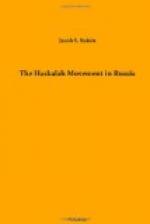Nicholas was paid measure for measure, and the cunning of his ministers was made of no avail by the shrewdness of his Jewish subjects. The report of the Minister of Education, at the end of 1845, shows incredible progress. It states that since the ukase of November 13, 1844, i.e. in the course of a single year, more than two thousand schools of different grades were established in various cities of the Pale, with more than one hundred and eighty thousand pupils, not including the technical schools in Odessa, Riga, Kishinev, Vilna, and Uman, with their hundreds of students! The truth was that, instead of the reported Russification, there had set in a vigorous reaction, which rendered the position more critical. Both sides had become desperate.[18] Some Maskilim, emboldened by the interest the Government evinced in their efforts, had resorted to all manner of means to accomplish their object, and frequently allied themselves with the oppressors. The Slavuta publishing house, it is claimed, was closed, and the Schapiras met with their tragic end, because “as printers they scrupulously abstained from publishing Haskalah literature.” Maskilim were employed by the authorities as tax collectors, and these, as is ever the case with rapacious farmers of taxes, besides executing the harsh laws of the tyrant, looked also to their own aggrandizement, and harassed their pious coreligionists in all ways conceivable. Many of them even hindered the colonization movement, because, if allowed to mature, it would deprive them of their income.[19] In addition to this, the Jews were now burdened, through the instrumentality of the Maskilim, with a tax on the candles lighted on Sabbath eve, yielding annually over one million rubles, the greater part of which went into the coffers of greedy officials. Another tax, also for the maintenance of the newly-organized Government schools, was levied—one kopeck and a half per page!—on text-books, whether imported from abroad or published in Vilna or Zhitomir, and the text-books were published with unnecessarily large type and wide margins to increase the number of pages. The abridgment and translation of Maimuni’s Mishneh Torah (St. Petersburg, 1851), superintended by Leon Mandelstamm, cost the Russian Jews tens of thousands of rubles, notwithstanding the expenditure of two or three millions on their own educational institutions, and at a time when every kopeck was needed for the support of the host of victims of fire, famine, and cholera, which ravaged many a city. Hence the reaction became more and more formidable. The cry grew louder and louder, Znaty nye znayem, shkolles nye zhelayem! ("We want no schools!"). The opposition, which began in the latter years of Alexander I, reached its culmination in the last decade of the reign of Nicholas I. “Israel,” laments Mandelstamm, “seems to be even worse than formerly; he is like a sick person who has convalesced only to relapse, and the physicians are beginning to despair.” It was a struggle not unlike that all over Europe at the beginning of the Renaissance, a struggle between liberty and authority, between this world and other-worldliness, between the spirit of the nineteenth century and that of the millenniums which preceded it.




